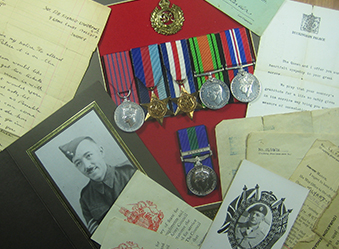
GEORGE MEDAL GVI,‘SEC. LDR. ALBERT HENRY TILYARD-BURROWS. H.G’, 1939-45 STAR, FRANCE AND GERMANY STAR, DEFENCE AND WAR MEDALS.
GENERAL SERVICE MEDAL GVI, CLASP MALAYA ‘22686246. SPR. D. H. BURROWS. R.E’
George Medal London Gazette 22 January 1941. The recommendation:
Section Leader A. H. TILYARD-BURROWS, VICKERS ARMSTRONG AIRCRAFT FACTORY UNIT, WEYBRIDGE [later part of 10th SURREY (VICKERS ARMSTRONG) BATTALION; then part of 3rd SURREY (WEYBRIDGE) BATTALION]
"On the morning of 21st September 1940 at about 08.30 hours the Vickers Aircraft Factory at Weybridge was attacked by an enemy aircraft. Three bombs were dropped, two of which exploded, doing slight damage. The other, a 500-lb. bomb, penetrated the factory roof, passed through a wall at the end and came to rest on the concrete driveway outside the erecting shed, having failed to explode. As the explosion of the bomb at the position where it rested would have caused considerable damage, its immediate removal was a matter of national importance. Lieutenant J. M. S. Patton, Royal Canadian Engineers, undertook to remove the bomb to a place of comparative safety and Section Leader Tilyard-Burrows together with Volunteers W. J. Avery, E. A. Maslyn and C. E. Chaplin, with complete disregard of personal safety and having no previous experience of handling unexploded bombs, immediately volunteered to assist.
The bomb was lashed to a sheet of corrugated iron, attached to a truck by wire cable and towed to a crater about 200 yards away where it could do no harm. The task was accomplished in little more than half-an-hour from the time the bomb had fallen. The bomb exploded the following morning. "Throughout the operation these men displayed cool courage of the highest order and contributed largely to the removal of a serious threat to the production of this factory."
Notes: Lieutenant J. M. S. Patton was awarded the George Cross and Captain D. W. C. Cunnington, also of the Royal Canadian Engineers, the George Medal for their gallantry on this occasion (L.G. 13.12.1940).
Albert Henry Tilyard-Burrows of Poplar. London, was born on 12 March 1903. Having previously served in the 6th Battalion Essex Regiment (Territorial Army), at the outbreak of the Second War, he was on reserved occupation and unable to enlist into the army. However, like many other able bodied men on reserved occupation, he joined the Local Defence Volunteers which were formed in May 1940 (renamed Home Guard some months later). Serving as a Section Leader of the 1st Battalion, Vickers Armstrong Aircraft Factory, Brooklands, Weybridge, this was presumably his place of work and therefore being on reserved occupation, couldn’t enlist into the Army.
produced Hawker Hurricanes and Wellington bombers among others and became a key target for the Luftwaffe. So much so, that on 4 September 1940 the factory was bombed resulting in horrendous losses of 83 workers killed and 419 injured……………
Condition GVF or better, court mounted and medals mounted on felt backed card frame, along with a Royal Engineers cap badge and a small name plaque. Additionally sold with a PDF of 1943 publication ‘The Home Guard of Britain’. An extremely fine and scarce Home Guard award.